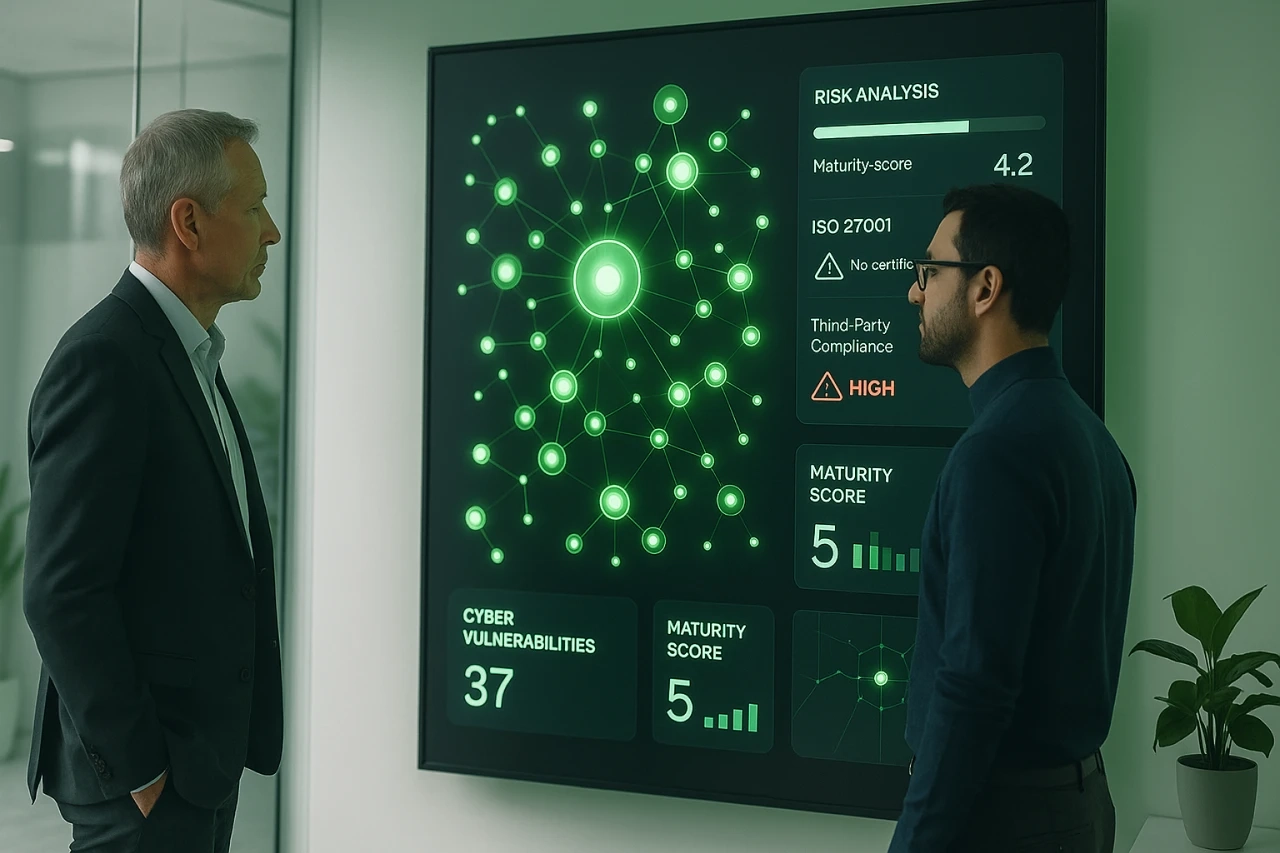Environmental Criteria for Third-Party Partner Evaluation

More and more companies are incorporating environmental preservation into their overall strategy. Whether through sustainable practices or compliance with the CSRD (Corporate Sustainability Reporting Directive), these organizations aim to reduce their ecological footprint. The evaluation of suppliers plays a crucial role in this process, using various environmental criteria to ensure a responsible supply chain.
What Is a Third-Party Partner Evaluation Guide?
An evaluation guide is an essential tool for companies that outsource activities while maintaining a high level of environmental compliance. This document sets out sustainability expectations that third-party partners must meet: waste management, reducing carbon footprint, and implementing specific ISO standards.
These guides define a set of performance indicators that providers must meet to remain competitive. These sustainability criteria promote proactive environmental management and a commitment to eco-responsible approaches.
Regulatory changes in 2025 have made this structured assessment even more essential. With the CSRD obligations and the implementation of the NIS 2 directive, companies must demonstrate full control of their value chains. This collaborative approach makes it possible to mutualize evaluations between partners and reduce the administrative burden on third parties.
Why Use Social and Environmental Criteria?
Incorporating social criteria when selecting partners helps promote better working conditions and ensures the respect of human rights. CSR (Corporate Social Responsibility) goes beyond environmental aspects to encompass major social issues.
By simultaneously combining social and environmental requirements, companies choose partners who share their values, reinforcing their brand image while minimizing non-compliance risks.
A recent Manutan study shows that 69% of buyers now include ethics in their selection criteria, a significant shift in procurement practices. This trend is also visible in the public sector, where France Loire has reached 90% supplier compliance through dematerialization with Aprovall.
How to Measure the Carbon Footprint of Partners?
The carbon footprint is a key measure of overall environmental impact, including that of external providers. Tools such as carbon audits allow companies to quantify emissions precisely and implement adapted reduction strategies.
This evaluation is more effective through partnerships with organizations specializing in carbon calculation and offsetting, ensuring objective measurement aligned with international standards.
In the construction sector, this approach is strategic. The decarbonization of construction relies on third-party evaluation, where measuring the carbon footprint of subcontractors is essential to meeting the objectives of the French National Low-Carbon Strategy.
Measuring the carbon footprint of third parties is part of a broader ESG approach
Discover how to effectively integrate ESG criteria into your supplier evaluation strategy for comprehensive environmental governance.
Waste Management and Performance Indicators
Effective waste management is a fundamental pillar of third-party environmental assessment. It begins with accurately identifying the volume and nature of the waste generated by each partner.
Compliance with relevant ISO standards, especially ISO 14001 for environmental management, adds an extra layer of credibility. This certification demonstrates a commitment to structured and measurable sustainable practices.
Performance indicators play a pivotal role in evaluating partners. These benchmarks track the progress of responsible actions, including:
- energy savings achieved,
- waste reduction or CO₂ emissions reduction.
In the industrial sector, industrial ecology is a driver of the ecological transition, where service pooling between actors supports national carbon reduction goals.
CSRD Compliance and ISO Standards Integration
CSRD requirements aim to ensure greater transparency in business practices, particularly around CSR commitments. They require companies to report in detail on their own operations and those of their partners.
The progressive rollout of the CSRD directive is reshaping the way external providers are assessed. This European regulation demands full control over the value chain, including the carbon footprint and sustainable practices of third-party partners.
The data collection methodology for Scope 3 under CSRD requires a collaborative approach between clients and providers, enabling efficient compliance through structured data collection. It also offers opportunities for competitive differentiation: companies that anticipate these requirements enhance their appeal to ESG investors and gain easier access to European green financing.
Adopting ISO standards in supplier assessment promotes harmonization of sustainable practices on a global scale. ISO 14001 provides a structured framework for continuously improving environmental performance, facilitating market access by eliminating trade barriers linked to environmental responsibility.
Benefits of a Rigorous Evaluation
Rigorous assessments encourage legal compliance and foster long-term business relationships. A well-selected partner builds trust and reduces the risk of supply chain disruption—especially important in a context where 38% of companies have experienced major third-party-related disruptions.
This approach generates tangible benefits:
- strengthened credibility with stakeholders,
- improved brand image,
- reduced risk of non-compliance,
- supply chain optimization,
- and easier access to green financing.
These benefits are especially relevant in the industrial sector, where vigilance also helps prevent fraud. TELT – Tunnel Euralpin Lyon Turin has shown that checking for banking fraud risk is crucial, as 58% of payment fraud cases originate from suppliers, underscoring the need for structured third-party governance to protect against external failures.
ESG: A New Strategic Lever to Manage Your Supply Chain
These concrete benefits of environmental evaluation take on strategic importance with new regulatory obligations. Explore how ESG is transforming your supply chain in light of 2025 challenges.
The Future of Environmental Criteria and Innovative Practices
Constant Regulatory Evolution
Environmental criteria are continuously evolving. New regulations like the CS3D directive and the EUDR regulation are transforming how companies assess their partners. These developments require businesses to transform their supply chains to meet the new 2025 ESG challenges.
Proactively adopting these changes helps companies establish a leadership position by integrating the latest innovations in environmental management.
Advanced Automation Technologies
Advanced technologies are increasingly used to monitor and optimize environmental performance. Artificial intelligence is revolutionizing third-party evaluation, enabling predictive analysis of environmental risks and continuous monitoring of sustainable practices.
For organizations managing large partner networks, documentary AI provides powerful predictive analytics. It automatically reviews documents submitted by partners, identifying discrepancies or failures to meet required sustainability standards, and integrates smoothly with CSRD data collection workflows.
Third-party governance automation is being transformed by major tech innovations. The integration of modules dedicated to CSRD allows for the automated collection of environmental data, reducing processing time for performance indicators by 75%.
This automation is especially effective in the continuous monitoring of environmental performance.
Sustainable governance: artificial intelligence is a game changer
Automated environmental evaluation represents the future of third-party governance. Learn how AI is transforming third-party evaluation and redefining your sustainability criteria management.
Real-Time Monitoring and Customization
Real-time multi-source monitoring is a major advancement for organizations handling hundreds of third-party partners. This technology instantly detects deviations from established environmental criteria, helping to prevent non-compliance before it disrupts the value chain.
In the public sector, this technology streamlines the management of public contracts and SPASER compliance, with APIs that enable real-time verification of certificates and documentation. This innovation addresses the French public sector’s enhanced transparency requirements.
These solutions thrive on a collaborative model where the secure mutualization of data allows organizations to benefit from collective intelligence. This approach significantly reduces supplier fatigue while maintaining high standards for sustainability criteria.
These articles might interest you
-
 01 July 2025Cyber Risk Among Suppliers: A Strategic Priority for Procurement TeamsSecteurAs a single cyberattack can now paralyze an entire production line, identifying cyber vulnerabilities within your supplier network is no longer optional. It has become a strategic lever, at the intersection of business continuity, compliance, and operational resilience. Data That Speaks for Itself Between 2021 and 2023, business disruptions caused by cyberattacks targeting suppliers surged […]
01 July 2025Cyber Risk Among Suppliers: A Strategic Priority for Procurement TeamsSecteurAs a single cyberattack can now paralyze an entire production line, identifying cyber vulnerabilities within your supplier network is no longer optional. It has become a strategic lever, at the intersection of business continuity, compliance, and operational resilience. Data That Speaks for Itself Between 2021 and 2023, business disruptions caused by cyberattacks targeting suppliers surged […]Read more
-
 18 August 2025Reindustrialization: Why Mastering Third Parties Is Now a Strategic ImperativeSecteurFrance’s reindustrialization is underway. Driven by the ambitions of the France 2030 plan, the ecological transition, and economic sovereignty challenges, it’s about much more than simply bringing factories back onto national soil. It requires a deep rethink of sourcing, evaluation, and supplier management processes. Restoring independence and economic sovereignty has become a major strategic issue […]
18 August 2025Reindustrialization: Why Mastering Third Parties Is Now a Strategic ImperativeSecteurFrance’s reindustrialization is underway. Driven by the ambitions of the France 2030 plan, the ecological transition, and economic sovereignty challenges, it’s about much more than simply bringing factories back onto national soil. It requires a deep rethink of sourcing, evaluation, and supplier management processes. Restoring independence and economic sovereignty has become a major strategic issue […]Read more
-
 20 May 2025Deploying a TPRM Platform in Private Companies: Proven Methodology for Effective Third-Party GovernanceSecteurIn a context where TPRM programs require executive-level support to succeed, deploying a TPRM platform is a major strategic challenge. While deployment in the public sector has its own regulatory specificities, multi-site private companies face distinct organizational challenges that call for a tailored methodological approach. This structured methodology transforms third-party evaluation into a true third-party governance lever, going beyond mere documentation compliance to […]
20 May 2025Deploying a TPRM Platform in Private Companies: Proven Methodology for Effective Third-Party GovernanceSecteurIn a context where TPRM programs require executive-level support to succeed, deploying a TPRM platform is a major strategic challenge. While deployment in the public sector has its own regulatory specificities, multi-site private companies face distinct organizational challenges that call for a tailored methodological approach. This structured methodology transforms third-party evaluation into a true third-party governance lever, going beyond mere documentation compliance to […]Read more
-
 22 May 2025DORA and NIS 2: Optimizing Governance of Critical Third PartiesSecteurUSD 9.5 trillion: that’s the estimated global loss from cybercrime in 2024, according to the World Economic Forum. If cybercrime were a country, it would be the world’s third-largest economy. In France, losses from cyberattacks are estimated at €100 billion in 2024. These two major regulations—the DORA (Digital Operational Resilience Act) and NIS 2 (Network and Information Security Directive 2)—transform how […]
22 May 2025DORA and NIS 2: Optimizing Governance of Critical Third PartiesSecteurUSD 9.5 trillion: that’s the estimated global loss from cybercrime in 2024, according to the World Economic Forum. If cybercrime were a country, it would be the world’s third-largest economy. In France, losses from cyberattacks are estimated at €100 billion in 2024. These two major regulations—the DORA (Digital Operational Resilience Act) and NIS 2 (Network and Information Security Directive 2)—transform how […]Read more
